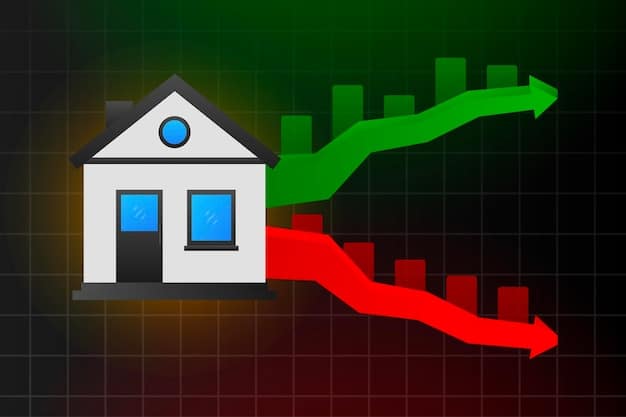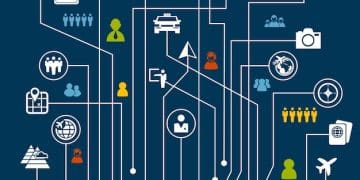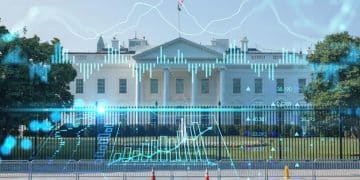The 2008 Financial Crisis: Lessons for the 2025 Economy

The 2008 Financial Crisis, triggered by the subprime mortgage market, led to a global recession; understanding its causes, responses, and long-term effects provides critical insights for preventing future economic crises, particularly as we assess the landscape of the 2025 economy.
The ripples of the **2008 Financial Crisis: Lessons Learned and Their Relevance to the 2025 Economy** are still felt today, shaping economic policies and influencing financial practices. Examining the origins, impact, and the subsequent responses to this crisis is more critical than ever as we navigate the complexities and uncertainties of the modern economic landscape.
Understanding the Genesis of the 2008 Financial Crisis
The 2008 Financial Crisis: Lessons Learned and Their Relevance to the 2025 Economy began with a seemingly localized issue in the U.S. housing market. However, the intricate web of financial instruments and global interconnectedness quickly transformed it into a widespread economic catastrophe.
The roots of the crisis can be traced back to the proliferation of subprime mortgages, which were offered to borrowers with poor credit histories.
Subprime Mortgages and the Housing Bubble
Subprime mortgages were a key factor in the crisis. Lenders relaxed lending standards, allowing more people to buy homes than ever before.
This, coupled with low-interest rates, fueled a housing bubble.
Securitization and the Spread of Risk
Mortgage-backed securities (MBS) and collateralized debt obligations (CDOs) spread the risk associated with subprime mortgages across the financial system.
- Securitization transformed individual mortgages into tradable securities, making them attractive to investors worldwide.
- CDOs bundled various MBSs, creating even more complex financial products.
- Credit rating agencies often gave these securities high ratings, further masking the underlying risks.

Ultimately, the crisis underscored the dangers of complex financial instruments and the importance of regulatory oversight.
The Immediate Impact of the Crisis: A Global Contagion
The 2008 Financial Crisis: Lessons Learned and Their Relevance to the 2025 Economy wasn’t contained within the U.S.; it quickly spread globally, impacting financial institutions, businesses, and individuals worldwide.
The collapse of Lehman Brothers in September 2008 marked a turning point, triggering panic in the financial markets.
Bank Failures and Bailouts
Many major banks faced liquidity crises and potential failures.
Governments around the world intervened with massive bailout packages to stabilize their financial systems.
Economic Recession and Job Losses
The financial crisis led to a severe economic recession.
- Businesses cut back on investments and laid off workers.
- Unemployment rates soared to levels not seen in decades.
- Global trade declined sharply, impacting economies dependent on exports.
The crisis highlighted the interconnectedness of the global economy and the potential for systemic risk.
Government and Central Bank Responses: Stabilizing the System
Governments and central banks around the world took unprecedented measures to respond to the 2008 Financial Crisis: Lessons Learned and Their Relevance to the 2025 Economy. These actions were aimed at stabilizing the financial system and mitigating the economic fallout.
Key responses included monetary policies and fiscal stimulus.
Monetary Policy Interventions
Central banks aggressively lowered interest rates to near-zero levels.
They also implemented quantitative easing (QE), purchasing assets to inject liquidity into the markets.
Fiscal Stimulus Packages
Governments implemented large-scale fiscal stimulus packages.
- These packages included tax cuts, infrastructure spending, and direct payments to individuals.
- The goal was to boost demand and stimulate economic growth.
- The effectiveness of these measures remains a subject of debate, but they played a crucial role in preventing a complete collapse of the economy.
These interventions helped prevent a deeper crisis but also led to debates about the appropriate role of government in the economy.
Regulatory Reforms: Preventing a Repeat of the Crisis
In the aftermath of the 2008 Financial Crisis: Lessons Learned and Their Relevance to the 2025 Economy, policymakers around the world enacted a series of regulatory reforms aimed at preventing a similar crisis in the future.
A key piece of legislation was the Dodd-Frank Wall Street Reform and Consumer Protection Act in the United States.
The Dodd-Frank Act
Dodd-Frank aimed to increase transparency and accountability in the financial system.
It created new regulatory bodies, such as the Consumer Financial Protection Bureau (CFPB).
Strengthening Capital Requirements
Regulators increased capital requirements for banks.
- This meant that banks had to hold more capital relative to their assets.
- The goal was to make banks more resilient to economic shocks.
- The Basel III framework, adopted internationally, also aimed to strengthen bank capital and liquidity standards.

These reforms sought to address some of the underlying causes of the crisis and make the financial system more stable.
Long-Term Economic Consequences: Lingering Effects
The 2008 Financial Crisis: Lessons Learned and Their Relevance to the 2025 Economy had long-lasting economic consequences that continue to affect the global economy today.
These include slower economic growth, increased income inequality, and changes in consumer behavior.
Slower Economic Growth
The crisis led to a period of slower economic growth in many countries.
This was due to factors such as deleveraging, reduced investment, and lower productivity growth.
Increased Income Inequality
The crisis exacerbated income inequality.
- The wealthy were able to recover more quickly due to their access to investment opportunities.
- Many middle-class and lower-income families lost their homes and savings.
- This increased social and political tensions in many countries.
The crisis highlighted the need for policies that promote inclusive growth and reduce inequality.
Relevance to the 2025 Economy: Lessons for the Future
Understanding the 2008 Financial Crisis: Lessons Learned and Their Relevance to the 2025 Economy is crucial for navigating the challenges and opportunities of the modern economic landscape. As we look ahead to 2025, several key lessons from the crisis remain relevant.
These include managing systemic risk, addressing inequality, and promoting sustainable growth.
Managing Systemic Risk
Systemic risk remains a concern in the global financial system.
Regulators must continue to monitor and address potential sources of instability.
Addressing Inequality
Inequality continues to be a major economic and social challenge.
- Policies aimed at promoting inclusive growth are essential.
- These include investments in education, job training, and affordable housing.
- Progressive taxation and social safety nets can also help reduce inequality.
The lessons of 2008 underscore the importance of proactive policymaking and international cooperation in preventing future crises.
| Key Point | Brief Description |
|---|---|
| ⚠️ Subprime Mortgages | High-risk loans led to a housing bubble. |
| 🏦 Bank Bailouts | Governments intervened to prevent bank failures. |
| ⚖️ Dodd-Frank Act | Regulatory reforms to prevent future crises. |
| 📈 Economic Inequality | Crisis exacerbated income inequality. |
Frequently Asked Questions
▼
The main cause was the proliferation of subprime mortgages, which led to a housing bubble. These high-risk loans, combined with complex financial instruments like MBS and CDOs, spread the risk throughout the financial system.
▼
Governments and central banks responded with massive bailout packages, monetary policy interventions like lowering interest rates, and fiscal stimulus packages. These measures were aimed at stabilizing the financial system and mitigating the economic fallout.
▼
Key regulatory reforms included the Dodd-Frank Act in the United States, which aimed to increase transparency and accountability in the financial system. Regulators also increased capital requirements for banks to make them more resilient.
▼
The long-term consequences included slower economic growth, increased income inequality, and changes in consumer behavior. Many countries experienced a period of deleveraging and reduced investment, impacting economic growth for years.
▼
Managing systemic risk, addressing economic inequality, and promoting sustainable growth are key lessons. Policymakers must continue to monitor and address potential sources of instability and implement policies that promote inclusive growth.
Conclusion
The 2008 Financial Crisis: Lessons Learned and Their Relevance to the 2025 Economy serves as a stark reminder of the interconnectedness of the global financial system and the potential for systemic risk. By understanding the causes and consequences of this crisis, and by learning from the policy responses that followed, we can better prepare for the economic challenges and opportunities of the future, fostering greater stability and prosperity for all.





